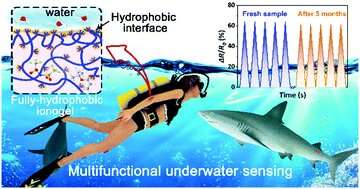Fully hydrophobic ionogel developed for wearable underwater sensor and communicator

The Smart Polymer Materials group led by Prof. Chen Tao at the Ningbo Institute of Materials Technology and Engineering (NIMTE) of the Chinese Academy of Sciences (CAS) has developed a fully hydrophobic ionogel which enables high-efficiency wearable underwater sensors and communicators in underwater operations. The study was published in Materials Horizons.
Wearable underwater sensing technology is indispensable for underwater operation, such as marine resource exploration, underwater rescue and underwater construction, owing to its crucial role in ensuring safety and improving efficiency of operation by detecting various signals.
Thanks to its advantages in tunable mechanical properties, biocompatibility and multifunctionality, ion-conducting gel is among the most promising materials for wearable sensors under low-humidity conditions. However, due to the instability of ion-conducting gel under long-term high-humidity environment, developing wearable sensors used in underwater sensing based on the ion-conducting gel remains challenging.
In this study, researchers at NIMTE developed a fully hydrophobic ion-conducting ionogel via the one-step polymerization of hydrophobic monomers in a hydrophobic IL solvent.
As a wearable underwater sensor, the prepared ionogel showed excellent long-term underwater stability. The diffusion barrier based on fully hydrophobic structure endowed it with outstanding anti-swelling capacity and suppressed the diffusion of ions effectively. The good hydrophobic properties enhanced the adhesion of ionogel in the underwater environment by destroying the hydration layer.
Additionally, the prepared ionogel exhibited high sensitivity, wide strain range, superior responsiveness and durability. As a demonstration, it can accurately detect the body motions of human and aquatic life in the complex underwater environment, showing the application potential in the field of posture monitoring and biological research.
By virtue of the coding principle of Morse code, a simple and efficient underwater communicator was proposed by matching finger bending status to the specific meanings (''dots'' and ''dashes'') and monitoring these finger bending motion under the water. Through the continuous combination of finger bending status, a series of underwater messages can be delivered efficiently.
The fully hydrophobic ionogel shows great potential in marine applications based on its excellent underwater sensing and communication performance, and it also provides a facile and effective route for developing next-generation wearable underwater sensors and communicators.
More information: Junjie Wei et al, A fully hydrophobic ionogel enables highly efficient wearable underwater sensors and communicators, Materials Horizons (2021). DOI: 10.1039/D1MH00998B
Provided by Chinese Academy of Sciences





















